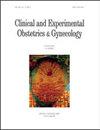Effect of Fluoxetine on Post-Hysterectomy Nursing of Patients with Endometrial Cancer: A Retrospective Study
IF 0.6
4区 医学
Q4 OBSTETRICS & GYNECOLOGY
引用次数: 0
Abstract
Background: The incidence and mortality of endometrial cancer (EC) have increased in recent years. The incidence of psychological disorders induced by EC is also increasing. Fluoxetine is a prescribed antidepressant drug for managing mental illnesses. We retrospectively explored the effect of fluoxetine intervention on symptom checklist 90 (SCL-90), quality of life, Hamilton anxiety scale (HAMA), Hamilton depression scale (HAMD), and nursing satisfaction in patients with EC undergoing surgery. Methods: One hundred patients with EC undergoing hysterectomy were selected. Based on the different clinical nursing intervention methods, the patients were categorized into a control group (n = 50) and an intervention group (n = 50). Patients in the control group were provided routine care, including nutrition guidance, basic psychological nursing, pain care, rehabilitation exercise, and complication prevention, whereas patients in the intervention group were only treated with fluoxetine based on routine nursing protocols. The differences in SCL-90, quality of life, HAMA, HAMD scores, and nursing satisfaction between the two groups were observed. Results: No significant difference was observed in the SCL-90, quality of life score, HAMA, and HAMD between the two groups before treatment. After treatment, all items in the intervention group differed from those in the control group. The SCL-90 scores of the intervention group decreased after treatment, and all subscales of SCL-90 in the intervention group were reduced. All dimensions of quality of life were elevated in the control group after treatment. The HAMA and HAMD scores of patients in the intervention group declined considerably after treatment. Conclusions: Fluoxetine intervention effectively improved the quality of life of patients with EC undergoing hysterectomy, and ameliorated signs of anxiety and depression, thus promoting the recovery of the disease.氟西汀对子宫内膜癌患者子宫切除术后护理的影响
背景:近年来,子宫内膜癌(EC)的发病率和死亡率呈上升趋势。EC引起的心理障碍的发生率也在增加。氟西汀是一种治疗精神疾病的处方抗抑郁药物。我们回顾性探讨氟西汀干预对EC手术患者症状自评量表90 (SCL-90)、生活质量、汉密尔顿焦虑量表(HAMA)、汉密尔顿抑郁量表(HAMD)及护理满意度的影响。方法:选择100例经子宫切除术的EC患者。根据临床护理干预方式的不同,将患者分为对照组(n = 50)和干预组(n = 50)。对照组患者给予常规护理,包括营养指导、基础心理护理、疼痛护理、康复锻炼、并发症预防等;干预组患者仅给予氟西汀常规护理方案。观察两组患者SCL-90、生活质量、HAMA、HAMD评分及护理满意度的差异。结果:治疗前两组患者的SCL-90、生活质量评分、HAMA、HAMD均无显著差异。治疗后,干预组各项指标与对照组差异显著。干预组治疗后SCL-90得分下降,干预组SCL-90各分量表得分均下降。治疗后,对照组的生活质量各方面均有所提高。干预组患者的HAMA和HAMD评分在治疗后明显下降。结论:氟西汀干预可有效改善EC子宫切除术患者的生活质量,改善焦虑、抑郁症状,促进疾病的康复。
本文章由计算机程序翻译,如有差异,请以英文原文为准。
求助全文
约1分钟内获得全文
求助全文
来源期刊
CiteScore
0.50
自引率
0.00%
发文量
241
审稿时长
1 months
期刊介绍:
CEOG is an international, peer-reviewed, open access journal. CEOG covers all aspects of Obstetrics and Gynecology, including obstetrics, prenatal diagnosis, maternal-fetal medicine, perinatology, general gynecology, gynecologic oncology, uro-gynecology, reproductive medicine, infertility, reproductive endocrinology, sexual medicine. All submissions of cutting-edge advances of medical research in the area of women''s health worldwide are encouraged.

 求助内容:
求助内容: 应助结果提醒方式:
应助结果提醒方式:


